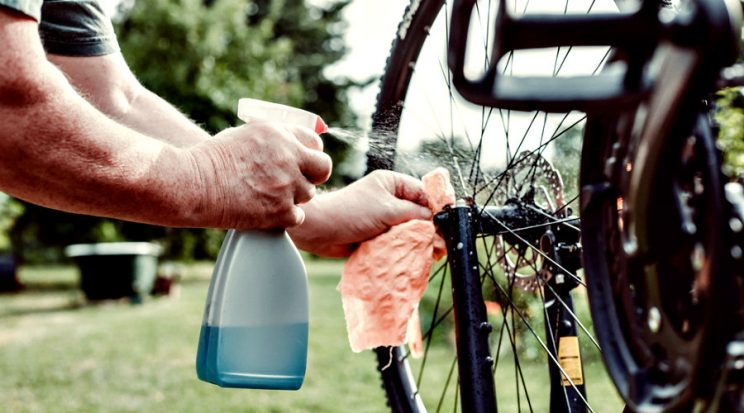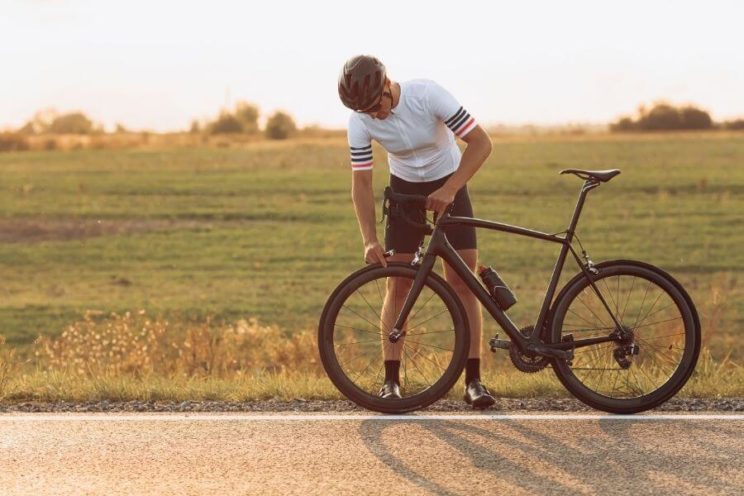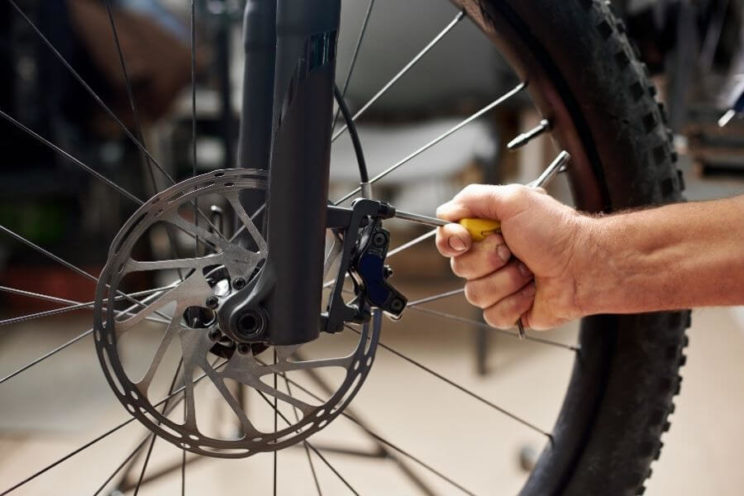We like it or not, the passage of the kilometers contributes to the deterioration of our bicycle. Even with exquisite care, wear will come, the need to replace pieces and the corresponding economic expense.
Given this, proper maintenance will contribute to your bike always offer its best version with a tight budget. How to achieve it? Here are some useful tips and strategies.
Keep your bicycle clean
Frequent cleaning is one of the most basic, and profitable maintenance routines, to prolong the useful life of your bicycle. Especially, if you pedal in mud or moisture conditions.
In addition to looking splendid, cleaning also protects the pieces of wear and helps keep corrosion and oxide at bay. In short, it guarantees that the entire mechanism works as expected.
To obtain the best results, it is advisable to use a specific bicycle cleaner. One of these spray products can do wonders. Spray the cleaner on the bike and let them act a few minutes before washing it. It is important that you do not use high pressures, since the essential fat of the most delicate union points of your machine can be carried.

Here are some bicycle cleaning accessories that can facilitate work:
- A clean rag. Have a few for each of the most routine tasks: cleaning, drying, greased, etc.
- Cleaning brushes. Use different shapes and sizes so you can access the most hidden parts of your bicycle and thus eliminate all the remains of dirt. A toothbrush can also be very useful.
- Chain degreaser. Use a specific degreaser for bicycles and avoid substances such as treem or kerosene, as they can corrode your machine's paint.
- Bicycle cleaner or soap. Ideally, a specific bicycle cleaner would be preferable; But a diluted dishwasher detergent is also a good option.
Alternatively, you can buy a specific cleaning kit for bicycles with different types of brushes, cleaner, degreaser, even rags.
Clean and lubricates conscientious transmission
Establishing a parallel, we could say that keeping the transmission clean is like changing the engine oil of a car.
In any case, lubricate the chain and clean the transmission prolongs the life of the bicycle, ensures a change of frictionless marches and allows softer driving. The frequency with which you must do this work will depend on the conditions of your routes, the weather, the benefits of the products you use, etc ...
If you are a sunny climate cyclist and walk just by road, you could allow you less frequent cleaning. But if on your routes moisture and mud are a constant, it will be essential that you clean and lubriquques the transmission after each output. Never forget to re -apply chain lubricant after this work.
Cleaning the transmission can be a somewhat tedious process. There are specific tools that can facilitate the work, such as the popular cleaning of Park Tool or similar. An utensil that allows you to catch the chain in a stagnant compartment full of liquid.
Alternatively, if you have barely shot a few kilometers, you can use a rag to clean the chain. Wrap it around the chain and turn the pedals back. That is better, of course.
[IRP Posts = "5635"]
Check the tire pressure
[Captation Id = "Attachment_6387" Align = "Alignnone" Width = "744"]

Image: Depositphotos[/caption]
Check the pressure of your bicycle tires every three or four days. You will be surprised by the amount of air that some tires can lose in just a few days, whether they ride a camera and if they use tubeless fluid. Rolling with inappropriate pressure affects adherence, braking capacity and tire wear.
A frequent mistake is to inflate the wheels to the eye until the wheel is hard to touch. Use a pressure meter to check that you are swelling the wheels at the right pressure. The ideal is to have a contracted quality pressure gauge. It is one of the best investments you can make.
The pressure of the tires depends on many factors, such as driving conditions, the conditions of the terrain, the size and type of the tires, the body weight, etc.
The wider the covers are, the lower the necessary air pressure to fulfill their function perfectly. Likewise, a slight difference in tire pressure can drastically affect handling and comfort on the bicycle.
In doubt, keep your pressures between the numbers recommended by the tire manufacturer, which are usually included in the flanks of the same.
[IRP Posts = "4232"]
Make sure nuts and bolts are tight
The pieces of your bike are kept together by dozens of bolts and nuts. It is obvious.
For that reason, there is nothing worse than a bicycle that falls apart while pedaling. Maintaining a tight bicycle is crucial, since nuts and loose bolts can cause severe wear, reduce performance and create a danger during the route.
The easiest way to keep the pieces of your bicycle intact is to make a rapid weekly review. You can slightly bounce the bicycle on the ground and be attentive to possible loose or badly tight unions.
When tightening these elements, consult the manufacturer's manual to know the specifications of Torque (force that applies to make something) correct. An insufficient adjustment could cause squeaks when pedaling, while excessive adjustment could damage the bicycle. If you have a carbon model, remember to always use a dynamometric key and adjust it to the right level levels.
Check the brakes

Ensuring that the brakes work as expected is important for your own safety and that of the cyclists around you. It is even more important if your route has many descents. You will not want your brakes to fail when you fly open to 70 km/hour.
To avoid problems, we invite you to follow some recommendations, of special application if you wear disc brakes on your bicycle:
- Try the brakes. Squeeze the handles and make sure the brakes work properly.
- Watch the wear of the brake pads. Most of them have a wear indicator. Be sure not to go beyond the indicated line.
- Watch the alignment of brake pads with the disc.
- If you use disc brakes, avoid contaminating them. That is, be sure to keep the discs clean so that the braking performance is not to see. You can use disc brake cleaners such as MUC-OFF, but never conventional multipurpose products.
Replaces worn and broken components
Does your bike make strange noises? Do not the transmission go as fine as before? Do you feel that braking is less effective over time?
Here are four bicycle components that you should check and replace instantly if you confirm that they have reached the end of their useful life. Your security and comfort is at stake, don't forget it.
Chain
It could be said that the chain is the most common bicycle component that needs to be replaced.
A typical bicycle chain is designed to cover between 3,500 and 7,000 km. Yes, we already know that it is a too broad fork, but it is true that it depends on the terrain, on the pedaling form of the cyclist, of the climate ... there are too many aspects to take into account. But what is clear is that it has to replace it when it suffers a significant stretch or wear.
Regular chain cleaning will allow you to squeeze it for more kilometers before requiring a replacement.
You can quickly check the chain wear with a simple metallic wear meter. An utensil that accurately measures the distance between two links. If the stretching of the chain is greater than 0.75 %, it is time to change. And it is that a worn chain will wear the cassette and the dishes, which could lead to much more expensive replacements.
Cassette
The cassette is another standard component of the bicycle that suffers wear. As a general rule, you will usually need a new cassette for each chain replacement.
In other words, a cassete will last two chains.
Sometimes, with proper transmission care and maintenance, the cassette can last up to 3 chains. If you feel that the gears jump after changing to a new chain, it is a sign that the crowns are worn out.
The disadvantage is that, although only one of the crowns is worn, you must replace the entire cassette, since manufacturers do not sell crowns separately.
Covered
The tires are direct victims of wear. Depending on the type of covers, they can wear out faster than the chain and cassette.
This is especially true in the case of tires that are used for races, which offer a soft compound, of great grip but little durability. In general, they last between 1,500 and 3,000 km, maximum. The high -end covers have an wear indicator that is very useful. In other cases, you must monitor and/or inspect them visually.
Brake pads
It is not necessary to frequently change brake pads. Precisely for that reason, there are many cyclists who overlook their wear and do not worry until the system begins to squeak. You can find wear indicators in most brake pads. Try to replace them before they reach their maximum wear.
 Here are some bicycle cleaning accessories that can facilitate work:
Here are some bicycle cleaning accessories that can facilitate work:
 Image: Depositphotos[/caption]
Check the pressure of your bicycle tires every three or four days. You will be surprised by the amount of air that some tires can lose in just a few days, whether they ride a camera and if they use tubeless fluid. Rolling with inappropriate pressure affects adherence, braking capacity and tire wear.
A frequent mistake is to inflate the wheels to the eye until the wheel is hard to touch. Use a pressure meter to check that you are swelling the wheels at the right pressure. The ideal is to have a contracted quality pressure gauge. It is one of the best investments you can make.
The pressure of the tires depends on many factors, such as driving conditions, the conditions of the terrain, the size and type of the tires, the body weight, etc.
The wider the covers are, the lower the necessary air pressure to fulfill their function perfectly. Likewise, a slight difference in tire pressure can drastically affect handling and comfort on the bicycle.
In doubt, keep your pressures between the numbers recommended by the tire manufacturer, which are usually included in the flanks of the same.
[IRP Posts = "4232"]
Image: Depositphotos[/caption]
Check the pressure of your bicycle tires every three or four days. You will be surprised by the amount of air that some tires can lose in just a few days, whether they ride a camera and if they use tubeless fluid. Rolling with inappropriate pressure affects adherence, braking capacity and tire wear.
A frequent mistake is to inflate the wheels to the eye until the wheel is hard to touch. Use a pressure meter to check that you are swelling the wheels at the right pressure. The ideal is to have a contracted quality pressure gauge. It is one of the best investments you can make.
The pressure of the tires depends on many factors, such as driving conditions, the conditions of the terrain, the size and type of the tires, the body weight, etc.
The wider the covers are, the lower the necessary air pressure to fulfill their function perfectly. Likewise, a slight difference in tire pressure can drastically affect handling and comfort on the bicycle.
In doubt, keep your pressures between the numbers recommended by the tire manufacturer, which are usually included in the flanks of the same.
[IRP Posts = "4232"]
 Ensuring that the brakes work as expected is important for your own safety and that of the cyclists around you. It is even more important if your route has many descents. You will not want your brakes to fail when you fly open to 70 km/hour.
To avoid problems, we invite you to follow some recommendations, of special application if you wear disc brakes on your bicycle:
Ensuring that the brakes work as expected is important for your own safety and that of the cyclists around you. It is even more important if your route has many descents. You will not want your brakes to fail when you fly open to 70 km/hour.
To avoid problems, we invite you to follow some recommendations, of special application if you wear disc brakes on your bicycle:












